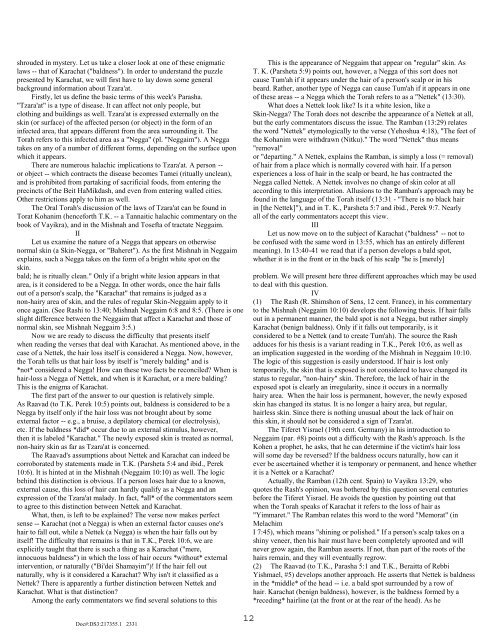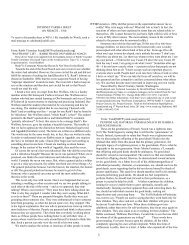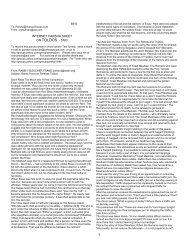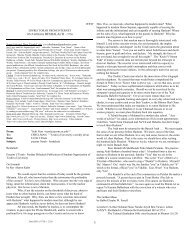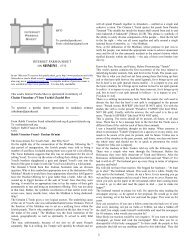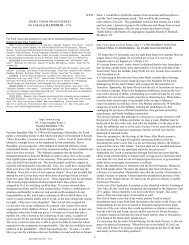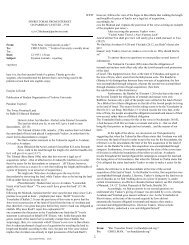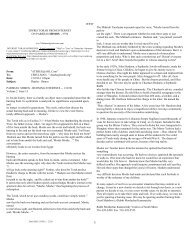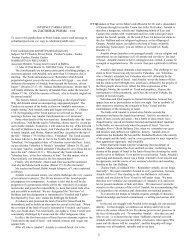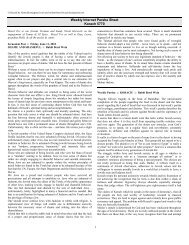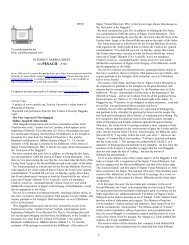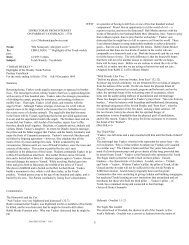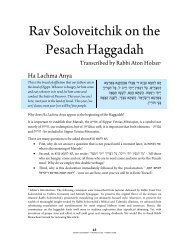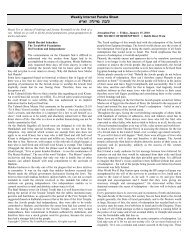ON PARSHAS TAZRIA-METZORA - 5756 - Internet Parsha Sheet
ON PARSHAS TAZRIA-METZORA - 5756 - Internet Parsha Sheet
ON PARSHAS TAZRIA-METZORA - 5756 - Internet Parsha Sheet
Create successful ePaper yourself
Turn your PDF publications into a flip-book with our unique Google optimized e-Paper software.
shrouded in mystery. Let us take a closer look at one of these enigmatic<br />
laws -- that of Karachat ("baldness"). In order to understand the puzzle<br />
presented by Karachat, we will first have to lay down some general<br />
background information about Tzara'at.<br />
Firstly, let us define the basic terms of this week's Parasha.<br />
"Tzara'at" is a type of disease. It can affect not only people, but<br />
clothing and buildings as well. Tzara'at is expressed externally on the<br />
skin (or surface) of the affected person (or object) in the form of an<br />
infected area, that appears different from the area surrounding it. The<br />
Torah refers to this infected area as a "Negga" (pl. "Neggaim"). A Negga<br />
takes on any of a number of different forms, depending on the surface upon<br />
which it appears.<br />
There are numerous halachic implications to Tzara'at. A person --<br />
or object -- which contracts the disease becomes Tamei (ritually unclean),<br />
and is prohibited from partaking of sacrificial foods, from entering the<br />
precincts of the Beit HaMikdash, and even from entering walled cities.<br />
Other restrictions apply to him as well.<br />
The Oral Torah's discussion of the laws of Tzara'at can be found in<br />
Torat Kohanim (henceforth T.K. -- a Tannaitic halachic commentary on the<br />
book of Vayikra), and in the Mishnah and Tosefta of tractate Neggaim.<br />
II<br />
Let us examine the nature of a Negga that appears on otherwise<br />
normal skin (a Skin-Negga, or "Baheret"). As the first Mishnah in Neggaim<br />
explains, such a Negga takes on the form of a bright white spot on the<br />
skin.<br />
bald; he is ritually clean." Only if a bright white lesion appears in that<br />
area, is it considered to be a Negga. In other words, once the hair falls<br />
out of a person's scalp, the "Karachat" that remains is judged as a<br />
non-hairy area of skin, and the rules of regular Skin-Neggaim apply to it<br />
once again. (See Rashi to 13:40; Mishnah Neggaim 6:8 and 8:5. (There is one<br />
slight difference between the Neggaim that affect a Karachat and those of<br />
normal skin, see Mishnah Neggaim 3:5.)<br />
Now we are ready to discuss the difficulty that presents itself<br />
when reading the verses that deal with Karachat. As mentioned above, in the<br />
case of a Nettek, the hair loss itself is considered a Negga. Now, however,<br />
the Torah tells us that hair loss by itself is "merely balding" and is<br />
*not* considered a Negga! How can these two facts be reconciled? When is<br />
hair-loss a Negga of Nettek, and when is it Karachat, or a mere balding?<br />
This is the enigma of Karachat.<br />
The first part of the answer to our question is relatively simple.<br />
As Raavad (to T.K. Perek 10:5) points out, baldness is considered to be a<br />
Negga by itself only if the hair loss was not brought about by some<br />
external factor -- e.g., a bruise, a depilatory chemical (or electrolysis),<br />
etc. If the baldness *did* occur due to an external stimulus, however,<br />
then it is labeled "Karachat." The newly exposed skin is treated as normal,<br />
non-hairy skin as far as Tzara'at is concerned.<br />
The Raavad's assumptions about Nettek and Karachat can indeed be<br />
corroborated by statements made in T.K. (Parsheta 5:4 and ibid., Perek<br />
10:6). It is hinted at in the Mishnah (Neggaim 10:10) as well. The logic<br />
behind this distinction is obvious. If a person loses hair due to a known,<br />
external cause, this loss of hair can hardly qualify as a Negga and an<br />
expression of the Tzara'at malady. In fact, *all* of the commentators seem<br />
to agree to this distinction between Nettek and Karachat.<br />
What, then, is left to be explained? The verse now makes perfect<br />
sense -- Karachat (not a Negga) is when an external factor causes one's<br />
hair to fall out, while a Nettek (a Negga) is when the hair falls out by<br />
itself! The difficulty that remains is that in T.K., Perek 10:6, we are<br />
explicitly taught that there is such a thing as a Karachat ("mere,<br />
innocuous baldness") in which the loss of hair occurs *without* external<br />
intervention, or naturally ("Bi'dei Shamayim")! If the hair fell out<br />
naturally, why is it considered a Karachat? Why isn't it classified as a<br />
Nettek? There is apparently a further distinction between Nettek and<br />
Karachat. What is that distinction?<br />
Among the early commentators we find several solutions to this<br />
Doc#:DS3:217355.1 2331<br />
12<br />
This is the appearance of Neggaim that appear on "regular" skin. As<br />
T. K. (Parsheta 5:9) points out, however, a Negga of this sort does not<br />
cause Tum'ah if it appears under the hair of a person's scalp or in his<br />
beard. Rather, another type of Negga can cause Tum'ah if it appears in one<br />
of these areas -- a Negga which the Torah refers to as a "Nettek" (13:30).<br />
What does a Nettek look like? Is it a white lesion, like a<br />
Skin-Negga? The Torah does not describe the appearance of a Nettek at all,<br />
but the early commentators discuss the issue. The Ramban (13:29) relates<br />
the word "Nettek" etymologically to the verse (Yehoshua 4:18), "The feet of<br />
the Kohanim were withdrawn (Nitku)." The word "Nettek" thus means<br />
"removal"<br />
or "departing." A Nettek, explains the Ramban, is simply a loss (= removal)<br />
of hair from a place which is normally covered with hair. If a person<br />
experiences a loss of hair in the scalp or beard, he has contracted the<br />
Negga called Nettek. A Nettek involves no change of skin color at all<br />
according to this interpretation. Allusions to the Ramban's approach may be<br />
found in the language of the Torah itself (13:31 - "There is no black hair<br />
in [the Nettek]"), and in T. K., Parsheta 5:7 and ibid., Perek 9:7. Nearly<br />
all of the early commentators accept this view.<br />
III<br />
Let us now move on to the subject of Karachat ("baldness" -- not to<br />
be confused with the same word in 13:55, which has an entirely different<br />
meaning). In 13:40-41 we read that if a person develops a bald spot,<br />
whether it is in the front or in the back of his scalp "he is [merely]<br />
problem. We will present here three different approaches which may be used<br />
to deal with this question.<br />
IV<br />
(1) The Rash (R. Shimshon of Sens, 12 cent. France), in his commentary<br />
to the Mishnah (Neggaim 10:10) develops the following thesis. If hair falls<br />
out in a permanent manner, the bald spot is not a Negga, but rather simply<br />
Karachat (benign baldness). Only if it falls out temporarily, is it<br />
considered to be a Nettek (and to create Tum'ah). The source the Rash<br />
adduces for his thesis is a variant reading in T.K., Perek 10:6, as well as<br />
an implication suggested in the wording of the Mishnah in Neggaim 10:10.<br />
The logic of this suggestion is easily understood. If hair is lost only<br />
temporarily, the skin that is exposed is not considered to have changed its<br />
status to regular, "non-hairy" skin. Therefore, the lack of hair in the<br />
exposed spot is clearly an irregularity, since it occurs in a normally<br />
hairy area. When the hair loss is permanent, however, the newly exposed<br />
skin has changed its status. It is no longer a hairy area, but regular,<br />
hairless skin. Since there is nothing unusual about the lack of hair on<br />
this skin, it should not be considered a sign of Tzara'at.<br />
The Tiferet Yisrael (19th cent. Germany) in his introduction to<br />
Neggaim (par. #8) points out a difficulty with the Rash's approach. Is the<br />
Kohen a prophet, he asks, that he can determine if the victim's hair loss<br />
will some day be reversed? If the baldness occurs naturally, how can it<br />
ever be ascertained whether it is temporary or permanent, and hence whether<br />
it is a Nettek or a Karachat?<br />
Actually, the Ramban (12th cent. Spain) to Vayikra 13:29, who<br />
quotes the Rash's opinion, was bothered by this question several centuries<br />
before the Tiferet Yisrael. He avoids the question by pointing out that<br />
when the Torah speaks of Karachat it refers to the loss of hair as<br />
"Yimmaret." The Ramban relates this word to the word "Memorat" (in<br />
Melachim<br />
I 7:45), which means "shining or polished." If a person's scalp takes on a<br />
shiny veneer, then his hair must have been completely uprooted and will<br />
never grow again, the Ramban asserts. If not, than part of the roots of the<br />
hairs remain, and they will eventually regrow.<br />
(2) The Raavad (to T.K., Parasha 5:1 and T.K., Beraitta of Rebbi<br />
Yishmael, #5) develops another approach. He asserts that Nettek is baldness<br />
in the *middle* of the head -- i.e. a bald spot surrounded by a row of<br />
hair. Karachat (benign baldness), however, is the baldness formed by a<br />
*receding* hairline (at the front or at the rear of the head). As he


